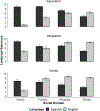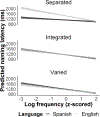Interactional context mediates the consequences of bilingualism for language and cognition
- PMID: 31580119
- PMCID: PMC7117987
- DOI: 10.1037/xlm0000770
Interactional context mediates the consequences of bilingualism for language and cognition
Abstract
Proficient bilinguals use two languages actively, but the contexts in which they do so may differ dramatically. The present study asked what consequences the contexts of language use hold for the way in which cognitive resources modulate language abilities. Three groups of speakers were compared, all of whom were highly proficient Spanish-English bilinguals who differed with respect to the contexts in which they used the two languages in their everyday lives. They performed two lexical production tasks and the "AX" variant of the Continuous Performance Task (AX-CPT), a nonlinguistic measure of cognitive control. Results showed that lexical access in each language, and how it related to cognitive control ability, depended on whether bilinguals used their languages separately or interchangeably or whether they were immersed in their second language. These findings suggest that even highly proficient bilinguals who speak the same languages are not necessarily alike in the way in which they engage cognitive resources. Findings support recent proposals that being bilingual does not, in itself, identify a unique pattern of cognitive control. An important implication is that much of the controversy that currently surrounds the consequences of bilingualism may be understood, in part, as a failure to characterize the complexity associated with the context of language use. (PsycInfo Database Record (c) 2020 APA, all rights reserved).
Figures






References
-
- Abutalebi J, Della Rosa, P. A., Green DW, Hernandez M, Scifo P, Keim R, ... & Costa A. (2012). Bilingualism tunes the anterior cingulate cortex for conflict monitoring. Cerebral Cortex, 22, 2076–2086. - PubMed
-
- Abutalebi J, & Green D (2007). Bilingual language production: The neurocognition of language representation and control. Journal of Neurolinguistics, 20, 242–275. doi:10.1016/j.jneuroling.2006.10.003 - DOI
-
- Abutalebi J, & Green DW (2016). Neuroimaging of language control in bilinguals: neural adaptation and reserve. Bilingualism: Language and Cognition, 19, 689–698. doi:10.1017/S1366728916000225 - DOI
-
- Aiken LS, West SG, & Reno RR (1991). Multiple regression: Testing and interpreting interactions. Newbury Park, CA: Sage.
-
- Antoniou M (2019). The advantages of bilingualism debate. Annual Review of Linguistics, 5, 1–21. doi: 10.1146/annurev-linguistics-011718-011820 - DOI

